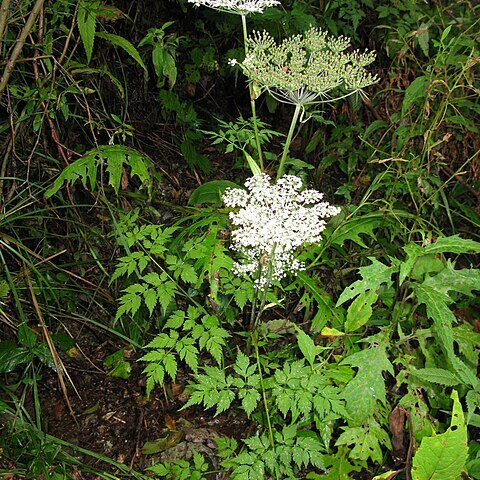Plants perennial, 0.5–1 m. Root conic, gray-brown. Stem solitary, purplish around nodes, thinly ribbed, glabrous or sparsely hispidulous above. Petioles up to 15 cm, sheaths narrow-oblong; blade triangular-ovate, 15–30 × 15–25 cm, 2–3-ternate-pinnate, rachis and petiolules geniculate; leaflets ovate or rhombic-oblong, 3–5 × 2.5–3.5 cm, irregularly 2–3-lobed and incised-cuspidate-serrate, scabrous along nerves bifacially or glabrous abaxially. Umbels 4–10 cm across; peduncles, rays and pedicels densely hispidulous; bracts absent or 1–3, narrow-lanceolate and ciliate; rays 10–20, 1.5–3 cm; bracteoles 7–10, narrow-linear, purplish, ciliate. Calyx teeth obsolete. Petals white, spatulate. Fruit oblong-ellipsoid, 6–7 × 3–5 mm; dorsal ribs prominent, narrow-winged, lateral ribs broad-winged; vittae 1 in each furrow, 2 on commissure. Fl. Aug–Sep, fr. Sep–Oct. n = 11*.
More
A herb. It keeps growing from year to year. It grows 1 m high. It has a single stem. This is cylinder shaped and hollow. It has ridges along it and is purple. The leaf stalks are 15 cm long. The leaf blades are triangle or oval shaped and 15--30 cm long by 15-25 cm wide. They are divided 2 or 3 times. The leaflets are oval and 3-5 cm long by 3-4 cm wide. They are 2 to 3 irregular lobes.
Damp habitats in mountains, C. and S. Japan. Forests, damp grasslands, streamsides; at elevations of 1,000-1,500 metres in China.
More
It is a temperate plant. It grows on the hillsides in north east China. It grows between 1,000-1,500 m above sea level.

